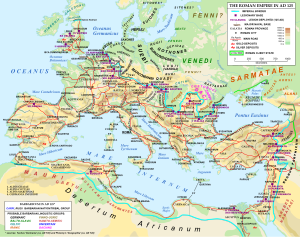
Legio septima Claudia Pia Fidelis (Seventh Claudian Legion) was a Roman legion. Its emblem, as well as of all Caesar's legions, was the bull, together with the lion.[citation needed]
The 7th, along with the 6th, 8th & 9th were all founded by Pompey in Spain in 65 BC.[1] They[citation needed] were ordered to Cisalpine Gaul around 58 BC by Julius Caesar, and marched with him throughout the entire Gallic Wars.
Legio VII was one of the two legions used in Caesar's invasions of Britain, and played a crucial role in The Battle of Pharsalus in 48 BC, and it existed at least until the end of the 4th century, guarding middle Danube.
Tiberius Claudius Maximus the Roman soldier who brought the head of Decebalus to emperor Trajan was serving in Legio VII Claudia.

Viminacium was a major city of the Romanann province of Moesia (today's Serbia), and the capital of Moesia Superior. Viminacium was the base camp of Legio VII Claudia, and hosted for some time the IIII Flavia Felix. It was destroyed in 440 by the Huns, but rebuilt by Justinian I. During Maurice’s Balkan campaigns, Viminacium saw destruction by the Avars in 584 and a crushing defeat of Avar forces on the northern Danube bank in 599, destroying Avar reputation for invincibility.
Today Kostolac, a small Serbian town on the Danube river, is located where Viminacium used to be.